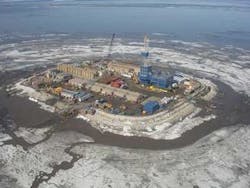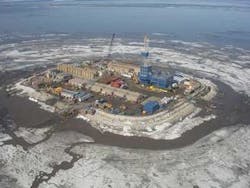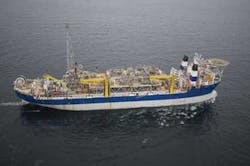GLOBAL E&P
Tracy Dulle • Houston
US
Production has begun from the Oooguruk Unit on the North Slope in Alaska, according to Pioneer Natural Resources Co.
The company anticipates peak gross production in 2010 of 15,000 to 20,000 b/d of oil from approximately 40 development wells (approximately half of the wells will be production wells and half will be injection wells). These wells are expected to be drilled over the next three years. The gross oil resource potential from these base development wells is as much as 90 MMbbl, before expansion opportunities, Pioneer says. The field life is expected to be 25 to 30 years.
In commissioning the system and evaluating initial production data, Pioneer expects to initially produce 2,000 to 3,000 gross b/d of oil from Oooguruk. Production is expected to be shut in for approximately 45 days this summer for scheduled maintenance on the onshore third-party processing facility. Thereafter, production will be reinitiated and is expected to rise as additional wells are brought online.
Latin America
Petróleo Brasileiro SA’s recent discovery in block BM-S-40 is confirmed to be light oil at 36º API.
Petrobras confirmed this by formation testing at 2,080 m (6,824 ft) with potential flow exceeding 12,000 b/d.
Petrobras says it plans to drill another exploration well immediately.
Africa
Afren has achieved first oil from the Okoro Setu project in OML 112, offshore Nigeria.
Initial production from the first of two wells drilled to date is flowing in excess of 3,000 b/d of 27º API gravity oil, which is in line with expectations, according to the company. The remaining wells will be batch drilled, with peak production of 15,000 b/d of oil expected in the third quarter.
The Mahogany-2 well that is being drilled to appraise the Jubilee field offshore Ghana, flowed at a test rate of 5,200 b/d of 36° API gravity crude oil and approximately 5.3 MMcf/d of associated natural gas, according to Tullow Oil.
The drillshipSonga Saturn drilled the well to 3,443 m (11,296 ft) TD in 1,080 m (3,543 ft) water depth. A single zone covering an interval of 17 m (56 ft) was tested through a 40/64-in. choke resulting in a flowing tubing head pressure of 1,540 psi.
These results confirm that the Turonian turbidite reservoirs of the Jubilee field are highly productive and validates the geological and reservoir model, Tullow says. The company will now acquire oil samples to conduct comprehensive refinery assays before the well is suspended as a potential development well and the rig released.
Noble Energy’s Benita oil appraisal well I-5 has encountered approximately 42 ft (13 m) of net oil pay, defined the water-oil contact, and moved the lowest known oil down structure approximately 28 ft (9 m), according to Noble.
Test results from the “high-quality” Miocene reservoir in block I offshore Equatorial Guinea yielded flow rates of 6,250 b/d and 5.4 MMcf/d of natural gas, with production rates limited by test equipment, the company says. Based on test information gathered, the Benita development wells are anticipated to produce approximately 10,000 b/d. Samples taken indicated a crude oil gravity of 30°.
Meanwhile, deepwater rigSedco 700 is preparing to drill the Diega prospect, an additional Miocene target north of Benita on block I. Diega, located in 2,165 ft (660 m) of water with a proposed well depth of 10,500 ft (3,200 m), has a gross resource potential of between 20 and 80 MMboe, according to Noble Energy.
“Flow tests have confirmed our initial expectations that Benita could produce at a rate of 50,000 b/d from just five wells,” says Charles D. Davidson, Noble Energy’s chairman, president, and CEO. “We are moving forward with the engineering and production studies to submit a plan of development by the end of the year, with hopes to sanction the project in 2009. Our target for first production from Benita remains 2012.”
North Sea/Europe
The Alvheim development offshore Norway has achieved first production, according to Marathon Oil. The company expects the combined Alvheim and Vilje projects to reach peak net production of approximately 75,000 boe/d by early 2009.
The Alvheim and Vilje developments are estimated to contain gross resources of approximately 250 MMboe.
The Alvheim development includes subsea infrastructure consisting of four drill centers and associated flow lines.
The UK Department for Business, Enterprise, and Regulatory Reform has approved plans for new field developments at West Don and Don South West in the North Sea. The fields are expected to peak at 50,000 b/d of oil in the first half of next year.
Also, John Hutton, secretary of state for Business, Enterprise, and Regulatory Reform, outlined plans to split new oil and gas fields out of existing but unprofitable fields. That change could affect 30 fields that would not be affected by the Petroleum Revenue Tax.
“High global oil prices are in part a signal that producing countries need to increase supply,” Hutton says. “All oil producing countries need to take action, and it’s therefore important for us to make sure we sustain the right environment to maximize recovery of the UK’s own reserves. The North Sea industry is of central importance to the British economy: it supports some 380,000 jobs, with investment worth around £5 billion ($9.8 billion) a year.”
First gas from the Shell UK-operated Shamrock field in the North Sea has been delivered to market.
The field is being developed with the Monotower platform design, which is being powered by wind and solar energy. Production throughput will average about 120 MMcf/d of gas. Gas is transported by pipeline to the Shell-operated Bacton Gas Plant approximately 120 km (74 mi) to the southwest.
Middle East
Dana Petroleum has made a gas discovery with its first exploration well offshore Egypt.
The WEB-1X well is the first drilled by the Dana Petroleum and Gaz de France partnership at the West El Burullus production sharing contract area within the Nile Delta region, offshore Egypt.
The WEB-1X well was drilled to 2,403 m (7,884 ft) TVD, targeting a Pliocene prospect consisting of a turbidite sandstone channel system. According to the company, the well encountered good quality gas bearing sands, and an extensive set of wireline logs were run.
A comprehensive multi-flowrate drillstem test of the reservoir sequence was completed, which flowed at rates of up to approximately 27 MMcf/d of gas. Dana said the well would be capable of delivering much higher gas flowrates in normal production mode than was seen during the drillstem test, because the test flowrates were limited by the temporary well completion and test equipment used on the jackup drilling rig.
The acquired data will be analyzed and an appraisal program will be defined. The WEB-1X well is being suspended for potential re-entry and future use as a gas production well.
Asia
Coastal Energy Co. has received government approval of the Production Area Application (PAA) for development of its Songkhla field in the Gulf of Thailand.
The PAA was approved by the Department of Mineral Fuels, and covers an extended area of approximately 75 sq km (29 sq mi,) which includes not only the Songkhla field, but several surrounding satellite features. The extended production area enables the company to fully exploit the prospects surrounding the primary Songkhla development without the need to apply for additional government approvals. As approved, the production area contains proved, probable, and possible reserves of 6.4 MMbbl of oil. It also contains eight identified oil prospects with potential oil in place of over 200 MMbbl of oil.
Songkhla field is expected to begin production in the fourth quarter of this year, with production drilling expected to begin in August 2008. Due to delays in the arrival of theSwiber Jack Up-1 (JU-1) rig, the company has revised its drilling program to ensure first production from Songkhla is not affected by the rig delay.
Following an International Licensing Round, Indonesia has awarded a new exploration block to Eni.
The West Timor block is offshore and onshore southwest Timor Island and encompasses some 4,075 sq km (1,573 sq mi), of which 2,725 sq km (1,052 sq mi) are offshore and 1,350 sq km (521 sq mi) onshore. Eni will be the operator and the sole holder of the license.
Total announced a significant discovery of gas and condensates on block B, offshore Brunei, in a water depth of 62 m (203 ft), approximately 50 km (31 mi) from the coast.
With a final depth of 5,850 m (19,193 ft), the MLJ2-06 well is the deepest ever drilled in Brunei in a high pressure/high temperature (HP/HT) reservoir. New gas compartments in the Maharaja Lela/Jamalulalam field have been detected and further appraisal work is necessary to evaluate them. However, this well should come onstream before the end of 2008, Total says.
Total, with a participation of 37.5%, is the operator of block B, in association with Shell (35%) and local partners (27.5%).
All three production wells in the Kambuna field, offshore North Sumatra, Indonesia, have now been tested and production has stabilized, according to field operator Serica Energy plc.
The final well, the Kambuna-4 production well, tested the Belumai reservoir over the 56 ft (17 m) interval to 7,154 to 7,210 ft (2,181 to 2,198 m) true vertical depth (TVD) below mean sea level and produced gas at a stabilized rate of approximately 41 MMcf/d (1 MMcm/d) together with approximately 2,900 b/d of 54º API condensate. The flowing wellhead pressure during this test was 1,444 psi. The Kambuna-4 well was drilled as a deviated well from the surface location of Kambuna-2 and reached a maximum deviation angle of 55º from the vertical.
Australia
The Glencoe-1 exploration well on Australia’s Northwest Shelf discovered natural gas in Upper Jurassic sandstones, operator Hess Corp. said. The well encountered 92 ft (28 m) of net gas pay, in line with pre-drill estimates and nearby Jurassic discoveries. Glencoe-1 is the first of four exploration wells being drilled on the 780,000-acre WA-390-P permit by Hess in 2008.
Glencoe-1 was drilled in 3,678 ft (1,121 m) of water by the semisubmersible rig,Jack Bates. Following the completion of the well, Jack Bates will move 14 km (8.7 mi) east to drill the Briseis prospect. The Briseis-1 well will test a separate structure in the same permit.
The Garfish-1 exploration well in production license VIC/L29, in the Gippsland basin offshore Victoria, has reached 2,410 m (7,907 ft) true vertical depth subsea, according to Nexus Energy Ltd.
The well has penetrated the primary exploration target above the Longtom field and initial indications from logging while drilling are that the predicted sands are water-bearing, the company says. This interpretation will be confirmed by subsequent wireline logs.
Current operations on the well are coring over a deeper interval that is interpreted to be the western extension of the main reservoir section of the Longtom field. Wireline log data will be acquired once the well has reached total depth to ascertain if gas bearing sands are present at this deeper level and if these sands are in pressure communication with the gas sands encountered in previous Longtom wells.
The primary target of the Garfish-1 well was to test a seismic anomaly that directly overlies the Longtom gas field. Similar seismic anomalies at Longtom had been shown to indicate the presence of gas bearing reservoir sands. The well was also deepened to appraise the western part of the VIC/L29 license area.


